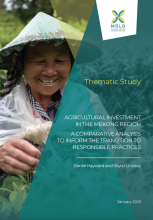Land Library Search
Through our robust search engine, you can search for any item of the over 73,000 highly curated resources in the Land Library.
If you would like to find an overview of what is possible, feel free to peruse the Search Guide.
/ library resources
Showing items 1 through 9 of 8955.South Africa's Expropriation Act of 2024, is at the centre of international controversy following lobbying by Afriforum and punitive actions by US President Donald Trump.
In the past two months Knowledgebase.land (KBL) has carried links to news highlighting recent developments in the region's mining sector across five countries.
Ethiopia’s economy and the livelihoods of its population are highly dependent on agriculture. The livelihood of about 84% of the population is directly depends on agriculture.
This analysis examines agricultural investment in the Mekong region, focusing on Cambodia, Laos, and Vietnam, to promote Responsible Agricultural Investment (RAI).
The Mekong Region has experienced rapid agrarian change over the past two decades, driven by public sector policies promoting agricultural commercialisation to alleviate rural poverty, provide income opportunities, and modernize agricultural production systems.
Best practices around five thematic communities of practice were highlighted in Knowledge Streams, including cross-cutting themes such as climate resilience, gender inclusivity, and digitalization.
In August 2020, the UN-Habitat Sudan Country Programme and the Global Land Tool Network (GLTN) published the “Darfur Land Administration Assessment: Analysis and Recommendations” report, developed in close cooperation with the United Nations Country Team of Sudan, the United Nations - African Uni
This research examines land value capture (LVC) as a strategic tool to finance urban infrastructure and support durable solutions for Internally Displaced Persons (IDPs) in Bosaso, Puntland's largest urban center and a key economic hub driven by its seaport, airport, and relative stability.
This paper presents the pilot experiences with a contributory model to customary land registration in Northern Uganda and discusses the potentials, challenges, and recommendations for further scaling up.







